Conference Report Samples
-
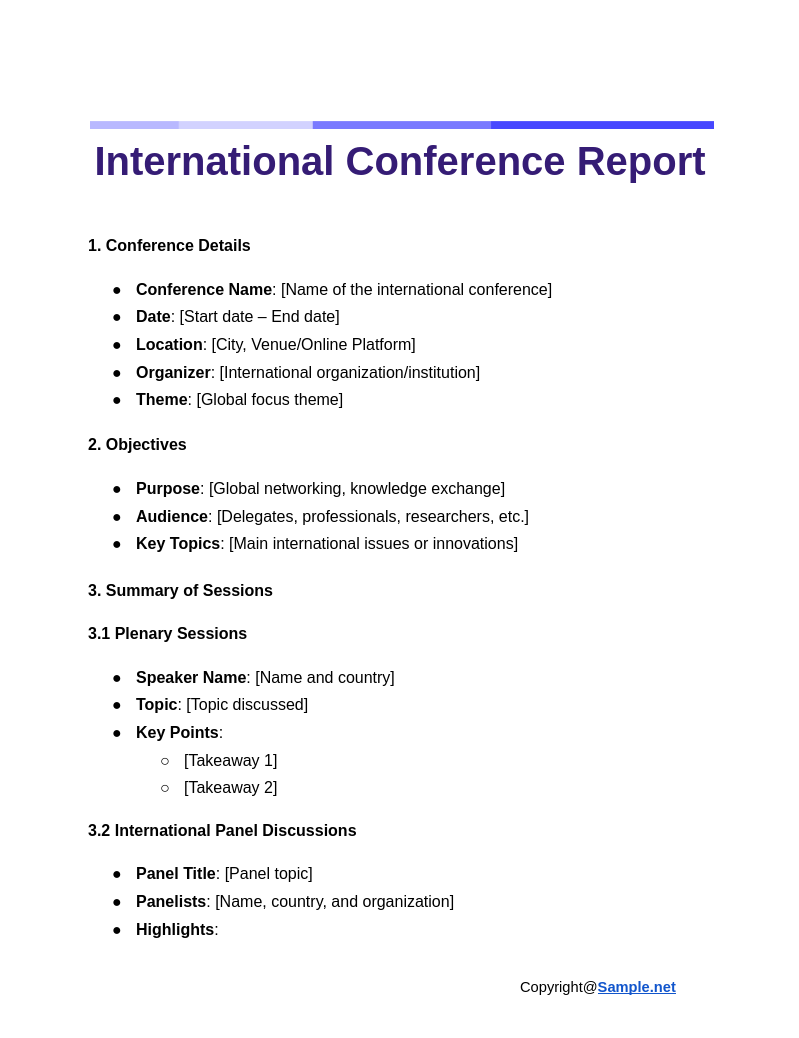
International Conference Report
download now -

Church Conference Report
download now -

Business Conference Report
download now -

Academic Conference Report
download now -
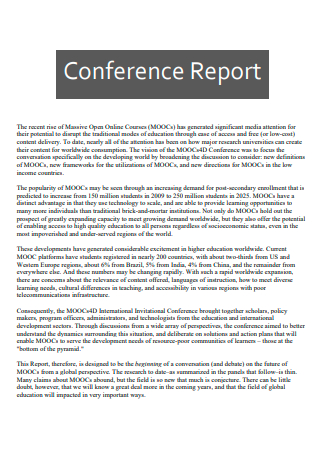
Conference Report Template
download now -
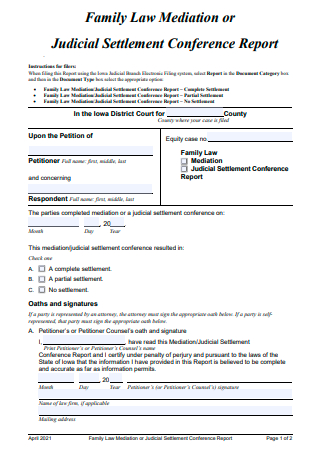
Judicial Settlement Conference Report
download now -
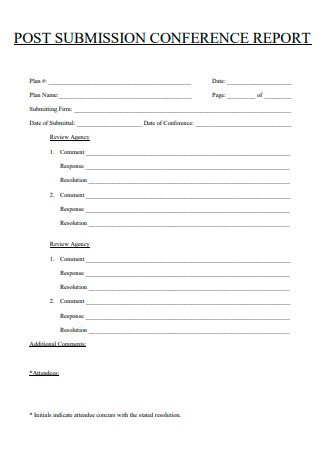
Post Submission Conference Report
download now -
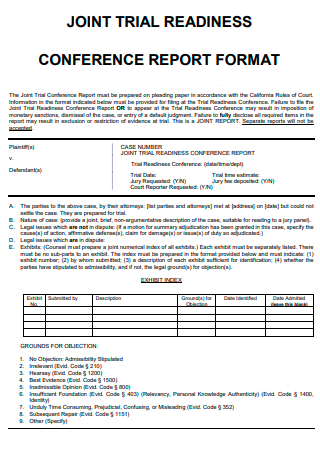
Conference Report Format
download now -
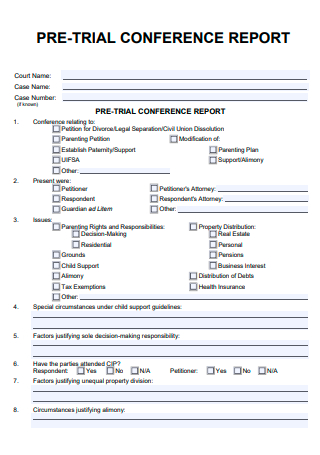
Pre-Trial Conference Report
download now -
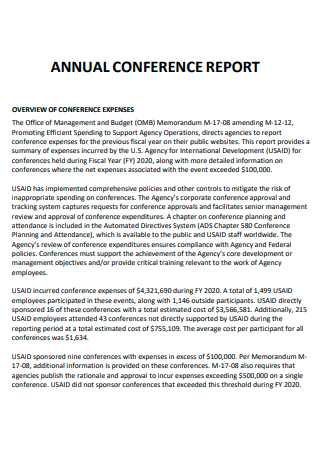
Annual Conference Report
download now -
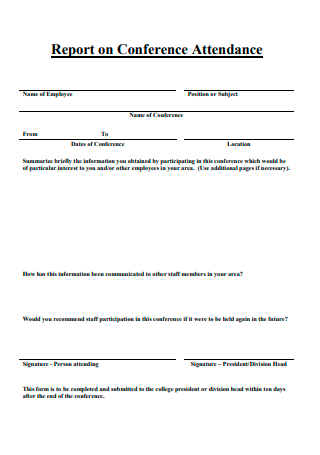
Conference Attendance Report
download now -
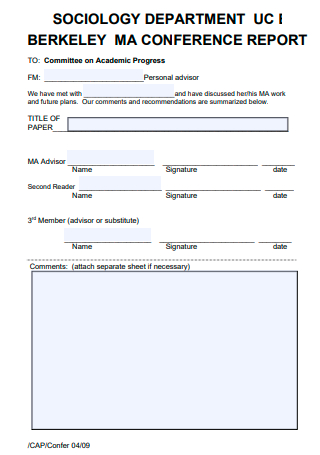
Basic Conference Report
download now -
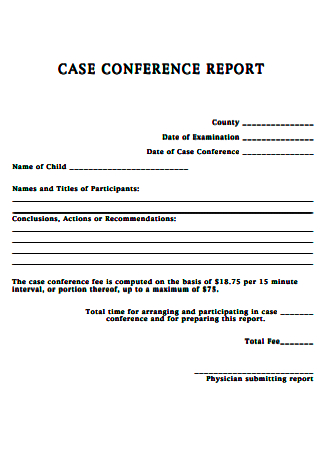
Case Conference Report
download now -

Conference Report in PDF
download now -
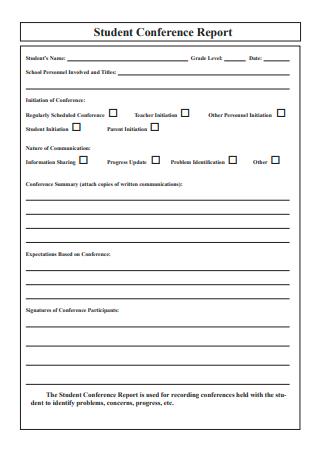
Student Conference Report
download now -
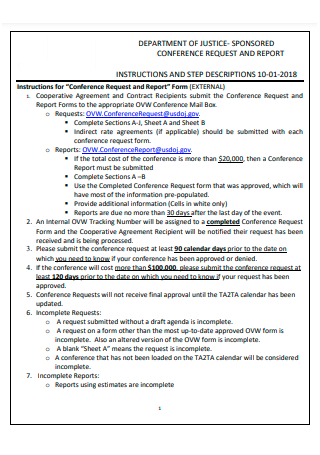
Conference Request and Report
download now -

Standard Conference Report
download now -
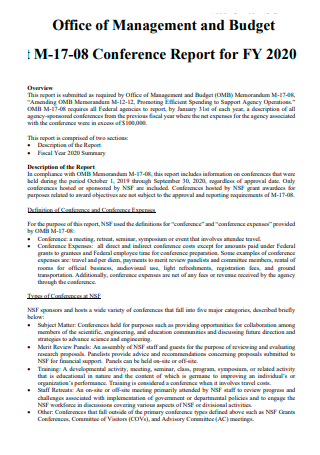
Office of Management and Budget Conference Report
download now -
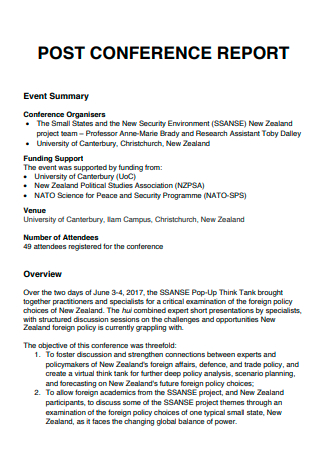
Post Conference Report
download now -
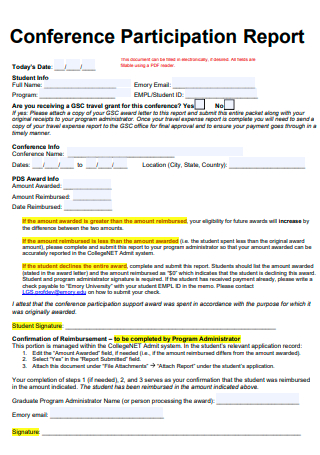
Conference Participation Report
download now -
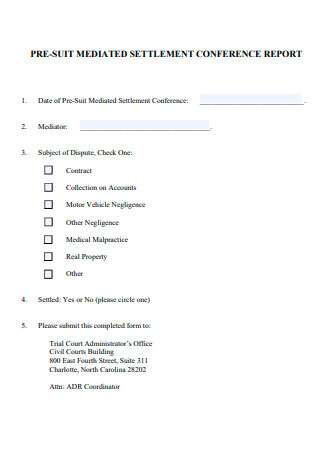
Settlement Conference Report
download now -

Preliminary Conference Report
download now -
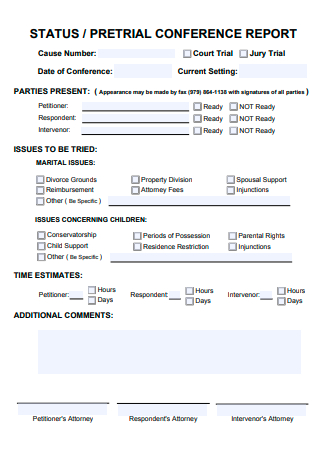
Status Conference Report
download now -

Legislative Conference Report
download now -

Advisory Conference Report
download now
FREE Conference Report s to Download
Conference Report Format
Conference Report Samples
What is a Conference Report?
Why Are Conference Reports Important?
What Are the Elements of a Conference Report?
How to Make a Conference Report in Easy Steps
FAQs
What is a conference report in research?
What is the purpose of conference proceedings?
How does a conference report help in decision-making?
What should be avoided while writing a conference report?
How can conference reports improve future events?
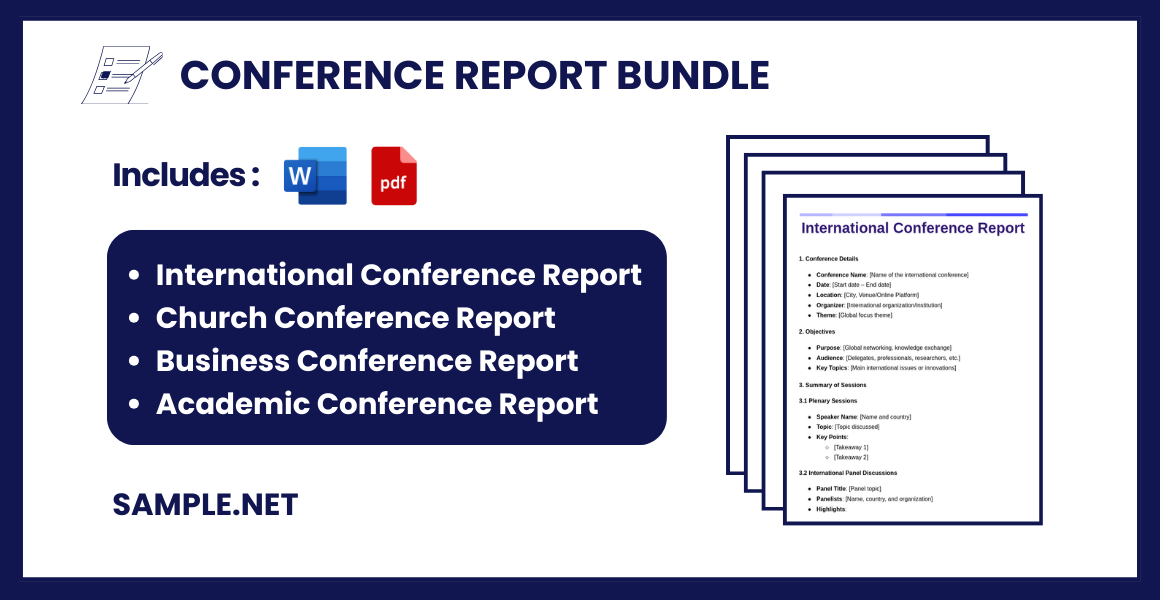
Download Conference Report Bundle
Conference Report Format
1. Conference Details
- Conference Name: [Name of the conference]
- Date: [Start date – End date]
- Location: [City, Venue/Online Platform]
- Organizer: [Name of the organizing body]
2. Objectives
- Purpose of the Conference: [State the main purpose of the conference]
- Target Audience: [Specify the audience, e.g., industry professionals, researchers, students]
- Key Topics Covered: [Summarize the main themes/topics]
3. Summary of Sessions
3.1 Keynote Speeches
- Speaker Name: [Name and designation]
- Topic: [Title of the speech]
- Key Takeaways:
- [Highlight 1]
- [Highlight 2]
- [Highlight 3]
3.2 Panel Discussions
- Panel Title: [Topic of the discussion]
- Panelists: [List of names and their affiliations]
- Key Insights:
- [Insight 1]
- [Insight 2]
3.3 Workshops/Seminars
- Workshop Title: [Name of the workshop/seminar]
- Facilitators: [Name and organization]
- Key Activities: [Summarize activities conducted]
- Outcomes: [List outcomes or skills gained]
4. Highlights
- Attendance: [Number of participants]
- Networking Opportunities: [Describe any opportunities for networking]
- Notable Achievements: [E.g., awards, agreements signed, partnerships formed]
5. Challenges and Improvements
- Challenges Faced: [List challenges, e.g., technical issues, scheduling conflicts]
- Suggested Improvements: [List recommendations for future conferences]
6. Key Learnings
- [Highlight key insights or knowledge gained from the conference]
7. Conclusion
- Overall Impression: [Summarize the conference’s success and impact]
- Next Steps: [Mention follow-up actions, such as sharing the report, implementing learnings]
8. Appendices (If Any)
- Photos: Attach relevant photos of the conference.
- Supporting Documents: Include brochures, handouts, or other materials.
- List of Attendees: [If applicable]
What is a Conference Report?
A conference report records all the significant processes, decisions, and developments discussed at a conference. Whoever is assigned to write the report should take notes during the conference. That way, the writing process comes off easy after the conference. Conference reports involve important information, such as the conference’s executive summary, so anyone who has not attended the conference can picture what went on at the conference and what the main takeaways from it are. You can also see more on Meeting Summary Report.
Why Are Conference Reports Important?
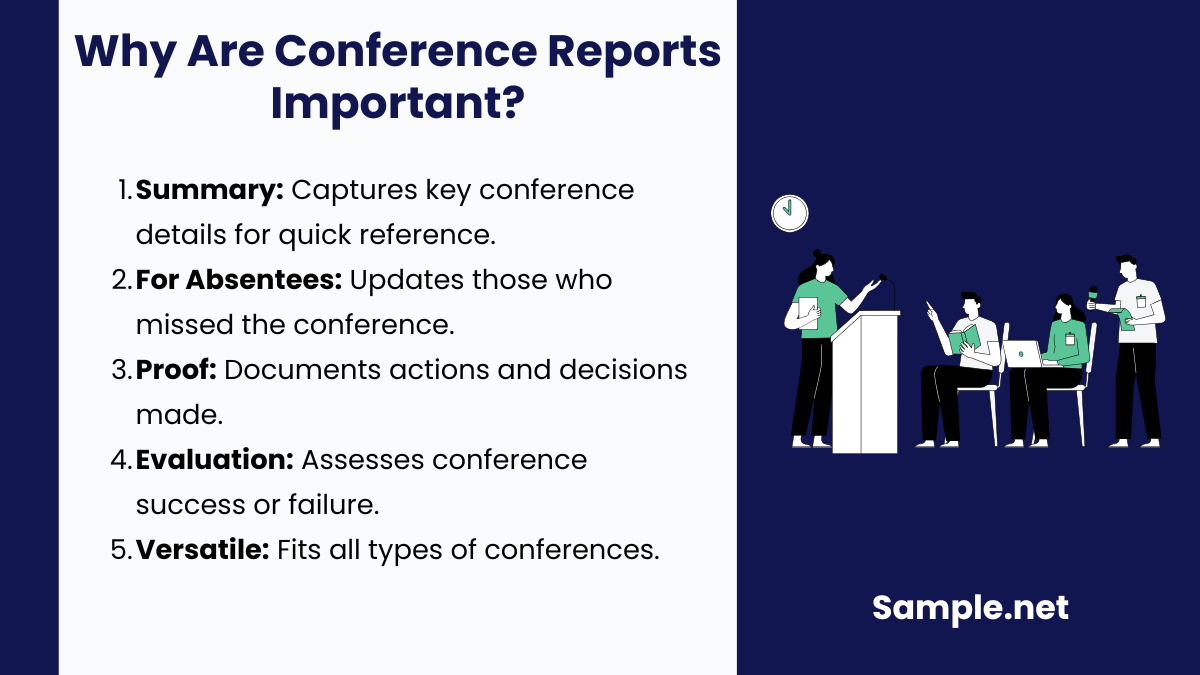
From the definition of a conference report alone, you can tell that it is a document that involves an arduous amount of effort and data. But why should you create one after a conference or a meeting? A conference is not just some fancy paperwork to submit for requirements’ sake. You can also see more on Press Reports. And here are the top reasons why a conference report is essential in any industry:
1. Overall Detailed Report
From the conference title, date, location, goals and objectives, down to the main points discussed at a conference, you can expect loads of information discussed inside a conference report. Conference reports are your best executive summaries in case you forget what happened during a conference. So if you have questions and clarifications to consider from a conference that was already done, simply refer to the conference report to catch up.
2. For People Who Failed to Attend the Conference
Speaking of catching up, a conference report is made for people who weren’t able to attend the conference itself. An example is when you organized a conference for specific employees. For the rest of the stakeholders who weren’t part of the conference but may want to know what was discussed in the conference, send them the conference report instead. And if the attendance sheet matters a lot about who was present and absent from a conference, it will also be noted in the report.
3. Proof of Action
A conference report is also useful as proof of action. Some conferences cover important topics such as legal actions, business decisions, and transactions. So rather than just basing on an action plan of a conference, a conference report is more credible since it is written after the conference. Use the report as proof of what occurred in a conference such as if there was a guest speaker in the conference, a document signed by the attendees during the conference, and other details.
4. Conference Analysis and Evaluation
Did you know that a conference report gives room for a conference evaluation and analysis report? After the conference, it is essential to break down whether the conference was a hit or a miss. Analyze in the conference report what factors caused the conference to be a success or a failure after thorough evaluation. You can use plenty of factors for analysis such as asking for the attendees’ feedback, checking if the conference goals and objectives were met, etc.
5. Various Conference Purposes
Conferences are not limited to businesses and legal departments alone. You can always set an academic conference, press conference, nonprofit conference, church conference, or a meeting discussing a conference proposal. And with every purpose per conference, expect a lot of topics to be covered. It can be hard to keep up sometimes with lots of information to memorize or put in your head. So it only makes sense to create a conference report after every conference no matter what the conference’s purpose is.
What Are the Elements of a Conference Report?
Indeed, conference reports involve numerous details that occurred during a conference. But there is also a common format as to how every detail is presented in the report. In this section, learn about the standard elements inside a conference report.
How to Make a Conference Report in Easy Steps
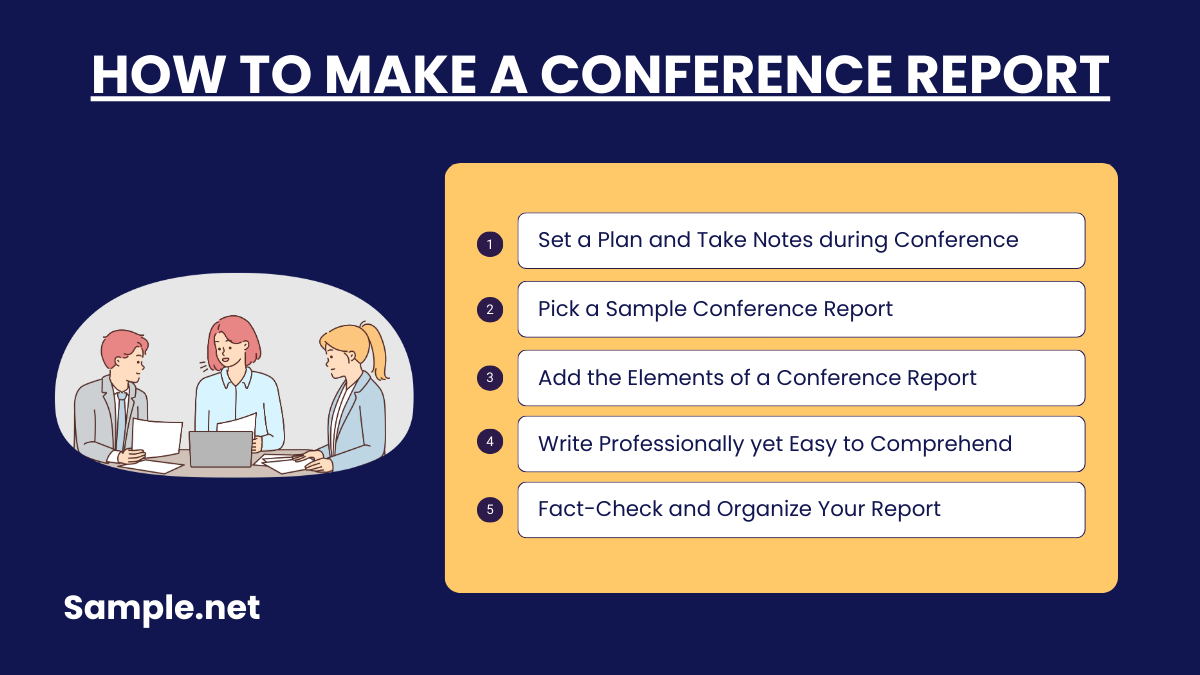
Conference reports give you thoughtful insights about anything from business communication, trial readiness, international trip agenda, to a congress committee decision. But no matter what purpose behind the conference was and how effective it was, the main question is how sure are you that you made an excellent conference report? You can also see more on Visit Report. For the real deal, here are the steps on how to create an effective conference report:
Step 1: Set a Plan and Take Notes during Conference
First, make a strategic plan of what details are covered from the conference that are worth inputting in the conference report. The key is to see the conference plan or agenda ahead as your basis. And during the actual conference, take notes and be observant of what happened, when something happens, and other details. Besides writing notes, assign someone else to take photos and videos during the conference in case there are things you missed in the report that you may notice after seeing those pieces of evidence.
Step 2: Pick a Sample Conference Report
There are a bunch of sample conference report templates in PDF and MS Word format waiting for you above this article. So don’t forget to check out each option and optimize the sample conference report template of your choice. Premade samples save you the hassle of writing conference reports from scratch. Instead, the rest of the formats and elements are outlined for you. And you have plenty of examples to select from including an academic conference report, joint case conference report, post-conference report, conference summary report, and more.
Step 3: Add the Elements of a Conference Report
Slowly complete your conference report’s elements from the title down to the recommendations section. Remember that is it through these elements that you can specify the essential parts of a conference report. If you lack the attendance sheet, executive summary, date and venue, or any vital component, your report would be incomplete. Nonetheless, you can still add more components to the report. For example, a conference that took too long may have covered lots of discussions so you can enumerate every discussion in the report.
Step 4: Write Professionally yet Easy to Comprehend
Just like how you write any business report, you should be formal and professional in writing the tone of your conference report. There is no need to write it as a personal letter because it is used for documentation. And just because a conference report is formal, it doesn’t mean that you force into using complex technical terms all throughout. Make it understandable for your audience to read so they won’t have a hard time following it.
Step 5: Fact-Check and Organize Your Report
Polish your work starting with fact-checking. The worst thing you can make in writing the conference report is when it contains inaccurate information. Be sure what has been recorded there is correct or verified. Also, you can simplify your report by organizing your details. A tip is to know how to arrange each element in the report such as writing with smooth transitions from one topic to another. And after a careful assessment of your report, it is ready to be submitted. You can also see more on Stakeholders Meeting Report.
FAQs
What is a conference report in research?
In research, a conference report refers to the critical data analysis based on numerous researches that were presented at a credible national or international conference.
What is the purpose of conference proceedings?
It is through conference proceedings that researchers get to explain their research in layman’s terms or in an informal way. It isn’t as formal as how journals are written. Also, conference proceedings give room for any researcher to post or share any research concept before actually developing it.
How does a conference report help in decision-making?
A conference report consolidates key insights and recommendations, providing stakeholders with clear guidance for decision-making. By highlighting outcomes and actionable points, it ensures alignment and fosters strategic planning. You can also see more on Brief Report.
What should be avoided while writing a conference report?
Avoid excessive jargon, irrelevant details, or subjective opinions. Focus on concise, factual, and actionable information for better readability and usefulness.
How can conference reports improve future events?
By including evaluations and feedback, conference reports highlight what worked well and areas needing improvement. This insight helps organizers refine their approach for better outcomes in future conferences. You can also see more on Summary Reports.
